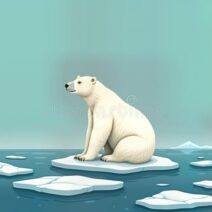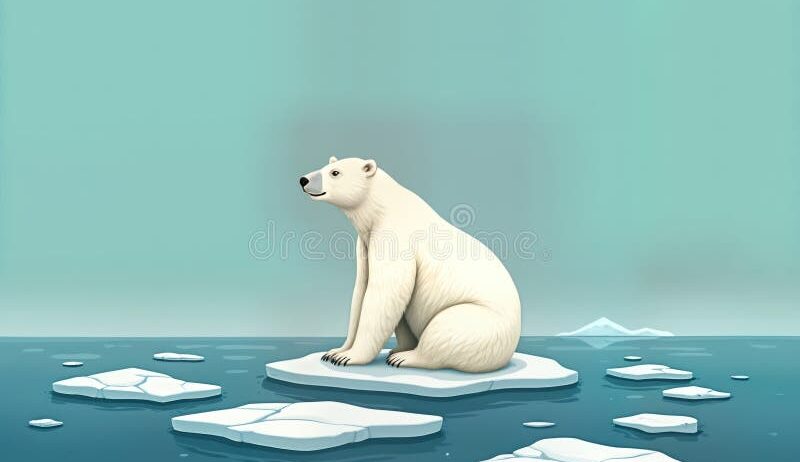The Arctic fox and the gray wolf are two remarkable creatures that embody the resilience and fragility of life in one of the planet’s most inhospitable environments—the Arctic. These species have adapted to extreme cold, a landscape characterized by its tundra, icy waters, and vast expanses of snow. However, a distressing phenomenon threatens their homes: global warming. The impacts of this climactic shift are reverberating throughout the Arctic ecosystem, impacting not only the immediate survival of these animals but also the delicate interconnections within their habitat.
The Arctic region is undergoing an alarming rate of warming, with temperatures rising nearly twice as fast as the global average. This rapid increase in temperature is a consequential result of anthropogenic activities, including fossil fuel consumption and deforestation. The melting of permafrost and the decline of sea ice are manifestations of a changing climate that do not merely pertain to environmental statistics; they affect the lives of Arctic inhabitants in profound ways.
As the ice melts, the very foundation of the Arctic ecosystem begins to disintegrate. For Arctic foxes and wolves, the loss of sea ice dramatically alters their hunting grounds. The Arctic wolf, a skilled predator, relies heavily on a stable ice surface to chase seals—its primary prey. With diminishing ice, not only is the wolf’s hunting efficiency compromised, but the overall availability of food dwindles. The direct correlation between ice extent and food availability is critical; as ice platforms shrink, so too do the chances for successful hunts, leading to starvation and decline in the population.
The Arctic fox, known for its cunning and adaptability, faces similar dire challenges. This small carnivore primarily feeds on lemmings, birds, and carrion, but its survival is intricately tied to snow cover. The insulating layer of snow allows these foxes to find and access their prey despite the freezing temperatures. However, as global warming causes unpredictable changes in snowfall patterns, Arctic foxes find it increasingly difficult to locate food. Unpredictable weather phenomena create conditions where snow is too sparse or melts too soon, profoundly affecting the population dynamics of lemmings and, consequently, the foxes that depend on them.
The interconnectedness of these species extends beyond mere food sources; it encapsulates a broader ecological web. Wolves act as apex predators in the Arctic, maintaining the balance of herbivore populations. A decline in population density of wolves usually leads to an increase in herbivorous species, which can in turn exert further pressure on vegetation in the tundra. The Arctic landscape is finely balanced; any shift in one species can propagate through the ecosystem, resulting in unforeseen ramifications that affect many other organisms.
Moreover, the habitat of these remarkable animals is also being encroached upon by increasing human activity as regions once covered in ice are opening up for exploration, transportation, and resource extraction. The oil and gas industry, among others, seeks to capitalize on these newly accessible territories. Such activities not only disrupt local habitats but also introduce pollution and lead to a greater likelihood of human-wildlife conflicts. The Arctic fox and wolves, unaccustomed to human presence, face harassment and threats, further complicating their struggle for survival in an increasingly artificial environment.
Climate change is not merely a future threat; it is a current reality for the Arctic’s wildlife. The notion that wildlife might adapt or migrate to new territories is hampered by the harsh conditions of the Arctic. While some species can indeed adjust to changing conditions, others, particularly those specialized to their particular habitats, struggle to adapt. Both Arctic foxes and wolves are integral components of their ecosystem. Their decline may herald a more extensive collapse of the Arctic ecological network.
While the plight of Arctic foxes and wolves serves as a cautionary tale about climate change, it also provides a lens through which we can explore broader ecological concepts. These apex predators and their prey exemplify how climate change catalyzes shifts in population dynamics, species interactions, and habitat use—the core constituents of biodiversity. The Arctic fox, a creature of adaptability, illustrates how species can endure despite the harshest conditions; yet, their tenacity is tested by anthropogenic influences. The wolf’s role as a keystone species reveals the interconnectedness of life forms and their reliance upon a balanced ecosystem. Both are threatened by heat, pollution, and invasive species that disrupt their existence.
Human intervention is vital if we hope to safeguard the Arctic ecosystem and the species that inhabit it. Conservational efforts must prioritize sustainable practices that minimize the anthropogenic footprint while promoting ecological restoration. Creating protected areas, enforcing environmental regulations, and fostering awareness about ecological responsibilities are essential steps towards minimizing further damage. Public support and policy advocacy are needed to combat climate change through collective climate action, ensuring that Arctic foxes and wolves can continue to thrive in their unique habitat.
Global warming is not a distant problem; it is a present and pressing challenge facing the Arctic regions and its wildlife. It serves as a stark reminder of our collective responsibility. The Arctic fox and wolf symbolize the urgency of our climate crisis, highlighting the need for immediate corrective measures. Their struggle for survival encapsulates the broader narrative of our planet’s biodiversity, compelling us to reevaluate our relationship with the environment as we witness the ongoing ramifications of climate change.



